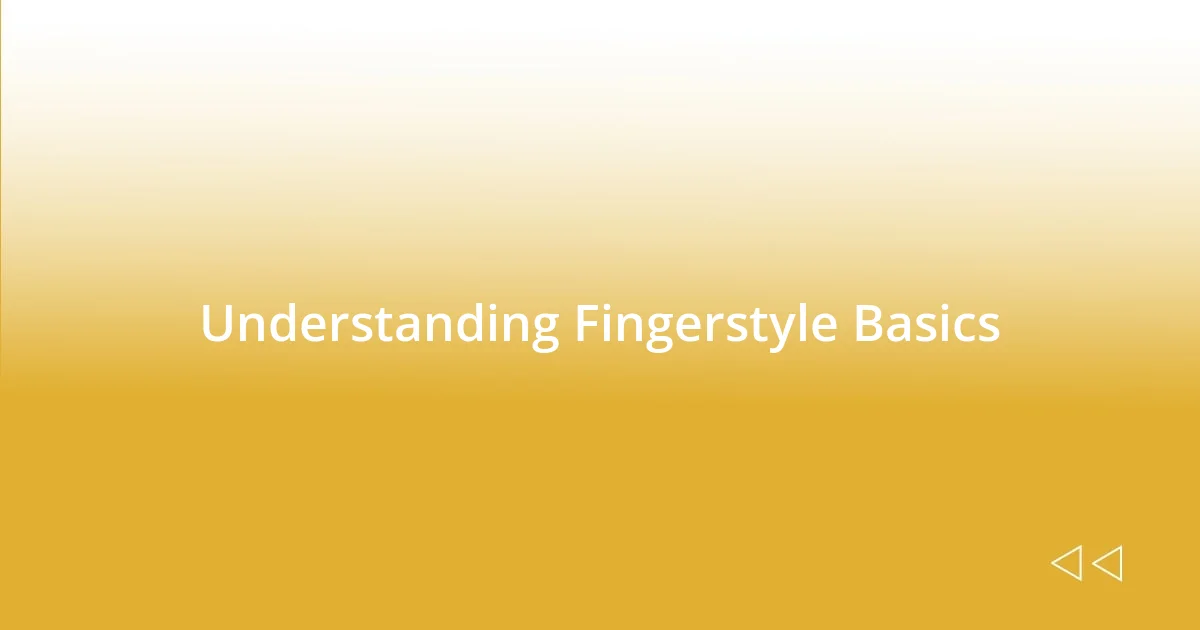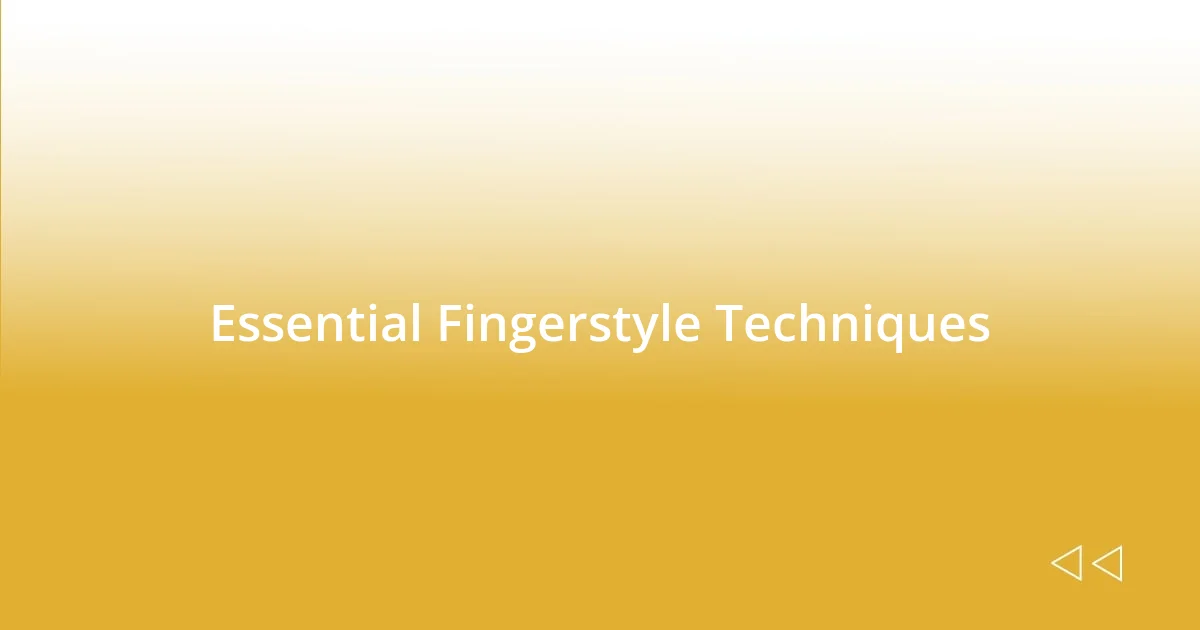Key takeaways:
- Fingerstyle guitar is a versatile technique that expresses emotions through distinct melodies and harmonies, encouraging personal musical discovery.
- Essential fingerstyle techniques, such as alternating bass and harmonics, build a strong foundation for improved playing and unique musical expression.
- Creating unique arrangements involves layering melodies and improvisation, allowing for personal creativity while transforming familiar songs into original pieces.

Understanding Fingerstyle Basics
Fingerstyle guitar is more than just a technique; it’s a unique way to express emotions through music. I remember the first time I strummed a chord while plucking the strings individually—I felt an instant connection to the instrument. Have you ever experienced that rush when a melody flows seamlessly from your fingers? It’s the foundation of fingerstyle, where each note rings out distinctly, creating a rich tapestry of sound.
At its core, fingerstyle involves using your fingertips or nails to pluck the strings, allowing for intricate melodies and harmonies. There’s something magical about the versatility this technique offers; you can play everything from classical pieces to modern pop songs. I often find myself getting lost in these different styles—each one brings out a different facet of my musical personality. Can you relate to that feeling of discovery in every note you play?
As you dive into fingerstyle, remember that practice is essential. I can’t stress enough how vital it is to start slowly, mastering the basic patterns before moving on to more complex arrangements. It’s okay to feel challenged; I’ve had countless moments of frustration turned into breakthroughs. Have you ever reached that tipping point where persistence pays off? Embrace the journey, and watch your skills grow!

Essential Fingerstyle Techniques
Creating a strong foundation in fingerstyle techniques can significantly enhance your playing. I recall a practice session where I focused solely on developing my thumb independence. It was challenging, but the moment I could pluck the bass notes while intertwining melodies with my fingers, I felt a surge of confidence and creativity. Here are some essential techniques that can elevate your fingerstyle skills:
- Alternating Bass: This involves using your thumb to play a bass note while your fingers pluck melodies. This technique adds depth and rhythm, mimicking a fuller sound.
- Arpeggios: Breaking chords into individual notes and playing them in succession allows for smooth melodic lines. It’s something I love in my arrangements because it adds a flowing quality.
- Pinching: Using your thumb and one or more fingers together creates a powerful, bright sound—perfect for emphasizing certain moments in a piece.
- Harmonics: Lightly touching the string while plucking creates ethereal notes. I remember the first time I achieved this; it felt like I was uncovering a new dimension of sound.
Incorporating these techniques into your practice will not only improve your fingerstyle ability but also help you develop your unique musical voice. Trust me; finding your sound in all this is a thrilling and rewarding journey!

Masters of Fingerstyle Guitar
When discussing masters of fingerstyle guitar, a few names immediately come to mind—classical virtuosos and contemporary innovators alike. For instance, Tommy Emmanuel is a true icon in the fingerstyle world. I remember watching one of his performances and being completely captivated by the combination of technical skill and emotional storytelling he brings to each piece. Have you ever felt that a guitarist made you see music in a new light? His energy and passion are contagious, inspiring players like myself to reach for new heights.
Another remarkable artist is Andres Segovia, often referred to as the father of classical guitar. His approach to fingerstyle was revolutionary, elevating the guitar to a respected status in classical music. I distinctly recall the first time I attempted to play one of his arrangements; it was daunting yet incredibly exhilarating. The way he used fingerstyle to blend melody and harmony taught me that every note is a brushstroke on a canvas of sound, turning each performance into an emotional journey.
Finally, let’s not overlook the modern-day trailblazers like Sungha Jung, who seamlessly merges traditional fingerstyle with contemporary music. Watching his videos, I often find myself awe-inspired by his fluidity and creativity. Just the other day, I tried learning one of his pieces, and although it pushed my limits, the learning process was nothing short of fulfilling. Isn’t it fascinating how different styles and eras of music can converge through a single technique? Each artist, in their own way, shows us the vast possibilities of fingerstyle guitar.
| Artist | Style |
|---|---|
| Tommy Emmanuel | Contemporary/Acoustic |
| Andres Segovia | Classical |
| Sungha Jung | Fingerstyle/Pop |

Practicing Fingerstyle Exercises
Practicing fingerstyle exercises can feel a bit daunting at first, but breaking it down can make it more manageable. I remember a time when I dedicated an entire week to mastering simple patterns. Every day, I’d set aside just 15 minutes to focus on one exercise. The sense of progress I felt, however small, each passing day was incredibly motivating. Have you ever experienced that same satisfaction when something finally clicks?
It’s essential to create a structured practice routine. I like to alternate between warm-up exercises and more challenging pieces, which keeps my mind engaged. For example, spending a few minutes on basics like the alternating bass pattern primes my fingers for more complexity later on. This approach not only builds my muscle memory, but it also instills a sense of rhythm that I carry through the rest of my practice. How do you structure your practice sessions?
Another effective way I practice is by incorporating songs I love into my exercises. I once tackled a beloved track that featured intricate fingerpicking. At first, it felt like an uphill battle, but slowly, as I broke it down note by note, the music began to take shape. That moment when I played through a section smoothly? Pure bliss! Using music you enjoy can transform the sometimes tedious practice into an exhilarating journey. What songs inspire you to pick up your guitar and dive into practicing?

Incorporating Rhythm and Dynamics
Incorporating rhythm and dynamics into fingerstyle guitar is vital for creating a captivating performance. I’ve found that experimenting with different tempos can completely alter the feel of a piece. Just last week, while practicing a familiar song, I decided to slow it down significantly. This change allowed me to explore the intricacies of each note, revealing subtle nuances that I had previously overlooked. Have you ever noticed how a slight shift in tempo can breathe new life into a melody?
Dynamics are equally critical. I remember a performance where I intentionally varied my picking volume, emphasizing certain chords while softening others. The audience’s response was palpable—their engagement heightened with each dynamic shift. It reminded me that music isn’t just about playing notes; it’s about telling a story. How do you use dynamics to convey your musical narrative?
One of my favorite techniques involves incorporating percussive elements into my playing. For instance, adding a light tap on the body of the guitar creates a rhythmic layer that complements the melody. During a jam session recently, I experimented with this technique on a popular folk song, and it transformed the listening experience. Have you ever played around with percussive sounds to enhance your music? I find it’s a fantastic way to push the boundaries of what the guitar can do.

Creating Unique Fingerstyle Arrangements
Creating unique fingerstyle arrangements is an exciting journey that encourages creativity and personal expression. I remember the first time I arranged a classic song, altering the chords and embellishing the melody to reflect my style. It felt as if I was rewriting history; transforming something familiar into a piece that resonated deeply with me. Have you ever felt that thrill in creating your own version of a song?
One technique I often utilize is layering different melodies. I’ll take a simple tune and play the main melody with my thumb while using my fingers to add harmonizing notes or counter-melodies. This not only enhances the arrangement but also gives it a richer texture. There was this one instance when I combined a beloved lullaby with a jazzy chord progression. The end result was soothing yet unexpected—it truly surprised everyone around me. What creative combinations have you stumbled upon in your own arrangements?
Another valuable approach is to embrace improvisation when crafting arrangements. Sometimes, I sit down with my guitar, let my fingers wander, and see where the music takes me. One evening, I began playing a basic chord progression, and before I knew it, I was weaving in unexpected rhythms and fingerstyle patterns. The spontaneity led to a unique piece I don’t think I would have developed otherwise. How often do you find yourself improvising? I believe that these moments of freedom can yield some of the most authentic and original musical creations.















